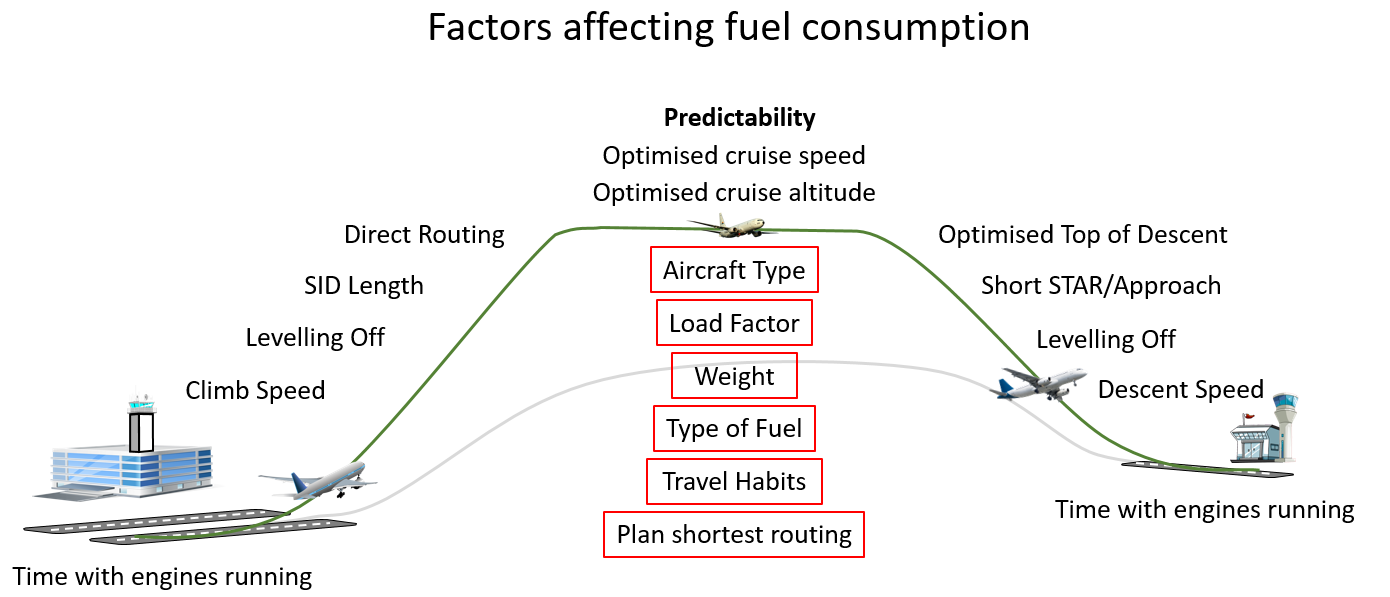EUROCONTROL provides support to stakeholders in the assessment of the environmental benefits and impacts following the implementation of new or existing operational concepts. Support comes via a range of services: independent evaluation, audit, undertaking environmental impact assessments, or other operational and technical analyses.

The Agency promotes the implementation of Continuous Climb Operations (CCO) and Continuous Descent Operations (CDO) for both fuel efficiency and the reduction of environmental impact. These, together with other operational mitigations, are discussed below.
For more information on aviation sustainability, click on the following link:
Continuous Climb and Descent Operations (CCOs and CDOs) are aircraft operating techniques enabled by airspace design, instrument flight procedure design and facilitated by air traffic control (ATC). CCO and CDO allow aircraft to follow a flexible, optimum flight path that delivers major environmental and economic benefits - reduced fuel burn, gaseous emissions, noise and fuel costs - without any adverse effect on safety.
CCO and CDO operations allow departing and/or arriving aircraft to climb or descend or continuously, to the greatest extent possible. Aircraft applying CCO employ optimum climb engine thrust and climb speeds until reaching their cruising levels. With CDO, aircraft employ minimum engine thrust, ideally from top of descent and in a low drag configuration, prior to the final approach fix. Employment of these techniques reduces intermediate level-offs and results in time being spent at more fuel-efficient higher cruising levels, hence significantly reducing fuel burn and lowering emissions and fuel costs.
Click here for more information on CCO/CDOs.

Point Merge is a systemised method for sequencing arrival flows, was originally developed by Europe in 2006, and is designed to work in high traffic loads without radar vectoring. It is based on an ATS route structure, consisting of a centre point (the merge point) and pre-defined set of legs (the sequencing legs) equidistant from this point. The sequencing is achieved with a “direct-to” instruction to the merge point at the appropriate time when the aircraft ahead has the required spacing for the runway throughput. The legs are only used to delay aircraft when necessary (“path stretching”); the length of the legs reflects the required delay absorption capacity
Depending on the operational and environmental constraints, and on the design choice made, these are the expected benefits:

- simplification of controller tasks, reduction of communications and workload
- better pilot situational awareness
- more orderly flows of traffic with a better view of arrival sequences
- improved containment of flown trajectories after the merge point
- better trajectory prediction, allowing for improved flight efficiency
- standardisation of operations and better airspace management.
Point Merge is a technique which can support Continuous Descent Operations (CDOs).
For more information, click here.
PBN can enable innovative and flexible use of airspace and procedures to reduce the impacts of noise on local communities.
However, the first thing to understand is whether the State or airport needs focused traffic flows or a widely dispersed set of aircraft tracks.
Focused traffic flows can be achieved with a single PBN route, reliant on RNP operations for tight aircraft performance. Track adherence on the turning segments can be assured by the use of RF turn performance. This should ensure that the number of people overflown and impacted by aircraft noise and visual disturbance will be kept to a minimum.
Alternatively, if a State or airport wishes to disperse the traffic load, then PBN offers the airspace designers the ability to define a series of routes to and from the runway ends which could be ‘switched on & off’ as required by arrival/departure operation. This set of noise respite routes will enable the service provide to spread the traffic load over a series of flight paths.
It should be noted that there is no single definition for respite and it is highly likely to mean different things to different people. Therefore, it is imperative that prior to an airspace change the designers clearly understand the type and respite required and the level of flexibility they have in defining new flightpaths.
CANSO has published a document looking at the Use of Performance Based Navigation (PBN) for Noise Management, which provides a set of Case Studies where PBN has been applied to mitigate environmental issues. This document can be accessed here.
The Radius to Fix (RF) path terminator functionality can be used in association with RNP 1, RNP 0.3, RNP APCH, and A-RNP specifications; RF is optional capability for RNP 1, RNP 0.3 and RNP APCH rather than a requirement as it is for A-RNP. This functionality can be used in the initial and intermediate approach segments, the final phase of the missed approach, SIDs and STARs.
Procedure designers are increasingly using RF capabilities to lever operational advantages and to ensure a high degree of track repeatability, which is not driven by a need to maintain a ground track due to terrain/obstruction issues. This is especially true when it comes to environmental mitigation. However, RF legs should be only be used when there is a requirement for a specific fixed radius curved path in a terminal procedure.
RF legs are intended to be applied where accurate repeatable and predictable ground track is required on the procedure. RF will prevent the dispersion of tracks experienced in other types of turn construction due to varying aircraft speeds, turn anticipation, bank, roll rate, etc. Although a reasonably high percentage of the European Commercial Air Transport (CAT) fleet is capable of RF, not all aircraft can execute this type of turn. Therefore, before a State designs RF legs in its procedures, the mix of aircraft and their capabilities and any possible alternatives should carefully be considered.
The use of RF legs to ensure a Noise Preferential Route (NPR) is maintained is applied at London Standsted (EGSS). Here RNP 1 SIDs with RF have been designed to ensure all aircraft follow the same ground track shortly after take off. The chart for RWY 04 is displayed on the right.